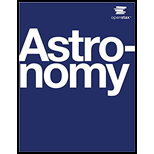
Astronomy
1st Edition
ISBN: 9781938168284
Author: Andrew Fraknoi; David Morrison; Sidney C. Wolff
Publisher: OpenStax
expand_more
expand_more
format_list_bulleted
Textbook Question
Chapter 11, Problem 4E
What are the seasons like on Jupiter?
Expert Solution & Answer
Want to see the full answer?
Check out a sample textbook solution
Students have asked these similar questions
Consider a rubber rod that has been rubbed with fur to give the rod a net negative charge, and a glass rod that has been rubbed with silk to give it a net positive charge. After being charged by contact by the fur and silk...?
a. Both rods have less mass
b. the rubber rod has more mass and the glass rod has less mass
c. both rods have more mass
d. the masses of both rods are unchanged
e. the rubber rod has less mass and the glass rod has mroe mass
8) 9)
10)
11)
12)
13)
14)
15)
Chapter 11 Solutions
Astronomy
Ch. 11 - What are the main challenges involved in sending...Ch. 11 - Why is it difficult to drop a probe like Galileo?...Ch. 11 - Explain why visual observation of the gas giants...Ch. 11 - What are the seasons like on Jupiter?Ch. 11 - What is the consequence of Uranus’ spin axis being...Ch. 11 - Describe the seasons on the planet Uranus.Ch. 11 - At the pressures in Jupiter’s interior, describe...Ch. 11 - Which of the gas giants has the largest icy/rocky...Ch. 11 - In the context of the giant planets and the...Ch. 11 - What is the primary source of Jupiter’s internal...
Ch. 11 - Describe the interior heat source of Saturn.Ch. 11 - Which planet has the strongest magnetic field, and...Ch. 11 - What are the visible clouds on the four giant...Ch. 11 - Compare the atmospheric circulation (weather) of...Ch. 11 - What are the main atmospheric heat sources of each...Ch. 11 - Why do the upper levels of Neptune’s atmosphere...Ch. 11 - How do storms on Jupiter differ from storm systems...Ch. 11 - Describe the differences in the chemical makeup of...Ch. 11 - How did the giant planets grow to be so large?Ch. 11 - Jupiter is denser than water, yet composed for the...Ch. 11 - Would you expect to find free oxygen gas in the...Ch. 11 - Why would a tourist brochure (of the future)...Ch. 11 - The water clouds believed to be present on Jupiter...Ch. 11 - Describe the different processes that lead to...Ch. 11 - Research the Galileo mission. What technical...Ch. 11 - How many times more pressure exists in the...Ch. 11 - Calculate the wind speed at the edge of Neptune’s...Ch. 11 - Calculate how many Earths would fit into the...Ch. 11 - As the Voyager spacecraft penetrated into the...Ch. 11 - The ions in the inner parts of Jupiter’s...
Additional Science Textbook Solutions
Find more solutions based on key concepts
8. Studies of DNA support which of the following?
a. Members of the group called australopiths were the first t...
Campbell Biology: Concepts & Connections (9th Edition)
Fibrous connective tissue consists of ground substance and fibers that provide strength, support, and flexibili...
Human Biology: Concepts and Current Issues (8th Edition)
Plants use the process of photosynthesis to convert the energy in sunlight to chemical energy in the form of su...
Campbell Essential Biology (7th Edition)
78. A breaker of nitric acid is neutralized with calcium hydroxide. Write a balanced molecular equation and a n...
Introductory Chemistry (6th Edition)
WHAT IF? Suppose two plant populations exchange pollen and seeds. In one population, individuals of genotype AA...
Campbell Biology in Focus (2nd Edition)
Use the key to classify each of the following described tissue types into one of the four major tissue categori...
Anatomy & Physiology (6th Edition)
Knowledge Booster
Learn more about
Need a deep-dive on the concept behind this application? Look no further. Learn more about this topic, physics and related others by exploring similar questions and additional content below.Similar questions
- Mick and Rick are twins born on Earth in the year 2175. Rick grows up to be an Earth-bound robotics technician while Mick becomes an intergalactic astronaut. Mick leaves the Earth on his first space mission in the year 2200 and travels, according to his clock, for 10 years at a speed of 0.75c. Unfortunately, at this point in his journey, the structure of his ship undergoes mechanical breakdown and the ship explodes. How old is Rick when his brother dies?arrow_forwardHi, I have canceled, why did you charge me again?arrow_forwardNo chatgpt pls will upvotearrow_forward
arrow_back_ios
SEE MORE QUESTIONS
arrow_forward_ios
Recommended textbooks for you
 AstronomyPhysicsISBN:9781938168284Author:Andrew Fraknoi; David Morrison; Sidney C. WolffPublisher:OpenStax
AstronomyPhysicsISBN:9781938168284Author:Andrew Fraknoi; David Morrison; Sidney C. WolffPublisher:OpenStax An Introduction to Physical SciencePhysicsISBN:9781305079137Author:James Shipman, Jerry D. Wilson, Charles A. Higgins, Omar TorresPublisher:Cengage Learning
An Introduction to Physical SciencePhysicsISBN:9781305079137Author:James Shipman, Jerry D. Wilson, Charles A. Higgins, Omar TorresPublisher:Cengage Learning Horizons: Exploring the Universe (MindTap Course ...PhysicsISBN:9781305960961Author:Michael A. Seeds, Dana BackmanPublisher:Cengage Learning
Horizons: Exploring the Universe (MindTap Course ...PhysicsISBN:9781305960961Author:Michael A. Seeds, Dana BackmanPublisher:Cengage Learning
 Foundations of Astronomy (MindTap Course List)PhysicsISBN:9781337399920Author:Michael A. Seeds, Dana BackmanPublisher:Cengage Learning
Foundations of Astronomy (MindTap Course List)PhysicsISBN:9781337399920Author:Michael A. Seeds, Dana BackmanPublisher:Cengage Learning Stars and Galaxies (MindTap Course List)PhysicsISBN:9781337399944Author:Michael A. SeedsPublisher:Cengage Learning
Stars and Galaxies (MindTap Course List)PhysicsISBN:9781337399944Author:Michael A. SeedsPublisher:Cengage Learning

Astronomy
Physics
ISBN:9781938168284
Author:Andrew Fraknoi; David Morrison; Sidney C. Wolff
Publisher:OpenStax

An Introduction to Physical Science
Physics
ISBN:9781305079137
Author:James Shipman, Jerry D. Wilson, Charles A. Higgins, Omar Torres
Publisher:Cengage Learning

Horizons: Exploring the Universe (MindTap Course ...
Physics
ISBN:9781305960961
Author:Michael A. Seeds, Dana Backman
Publisher:Cengage Learning


Foundations of Astronomy (MindTap Course List)
Physics
ISBN:9781337399920
Author:Michael A. Seeds, Dana Backman
Publisher:Cengage Learning

Stars and Galaxies (MindTap Course List)
Physics
ISBN:9781337399944
Author:Michael A. Seeds
Publisher:Cengage Learning
Kepler's Three Laws Explained; Author: PhysicsHigh;https://www.youtube.com/watch?v=kyR6EO_RMKE;License: Standard YouTube License, CC-BY